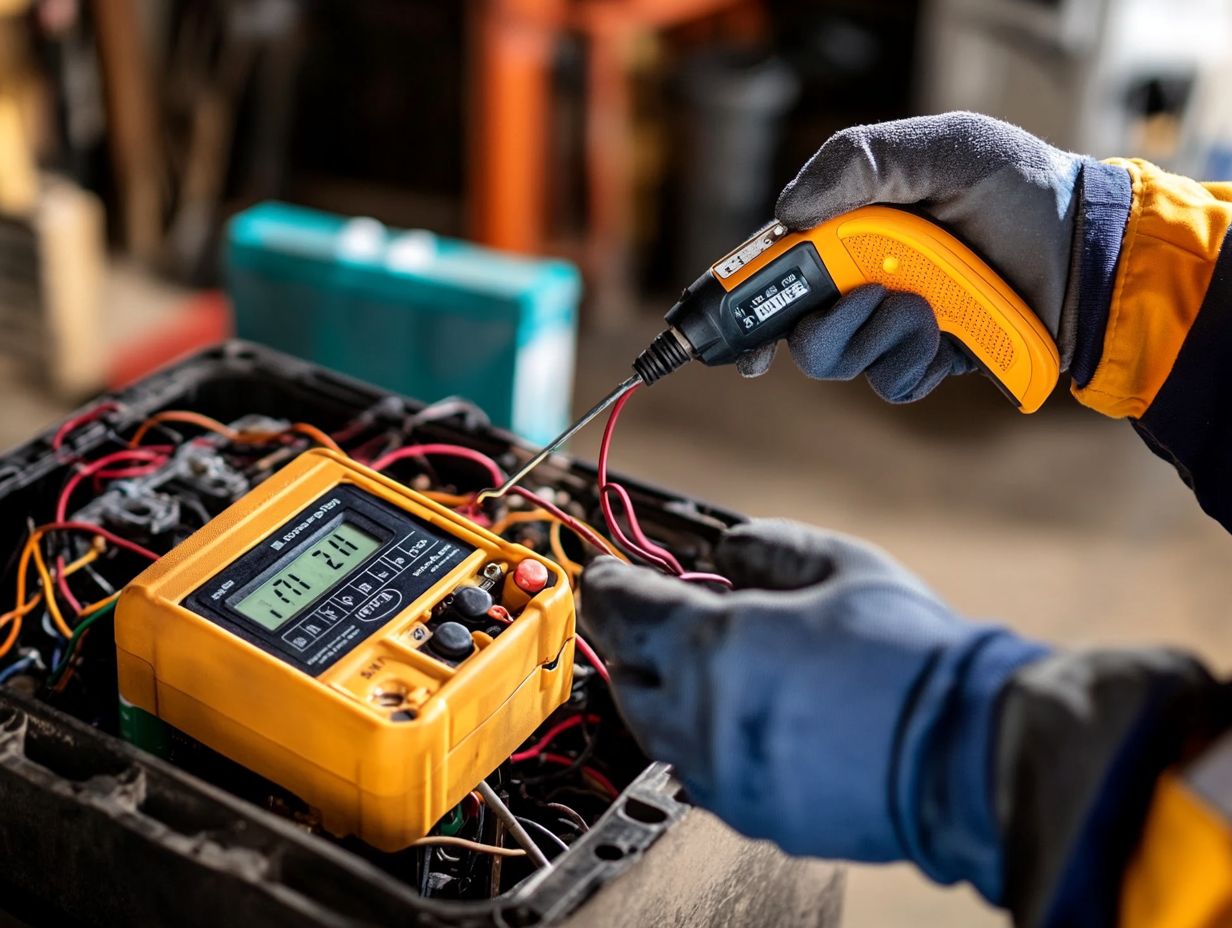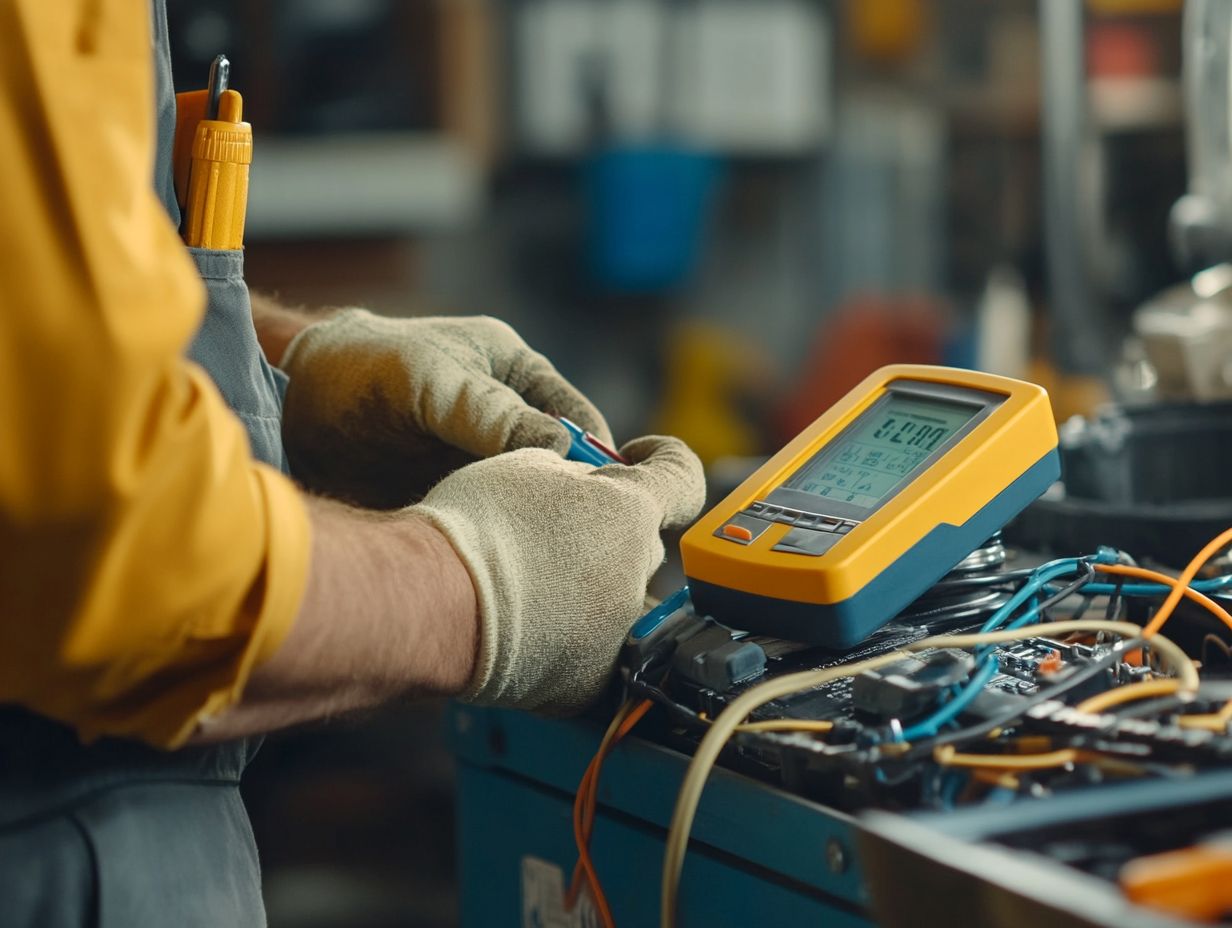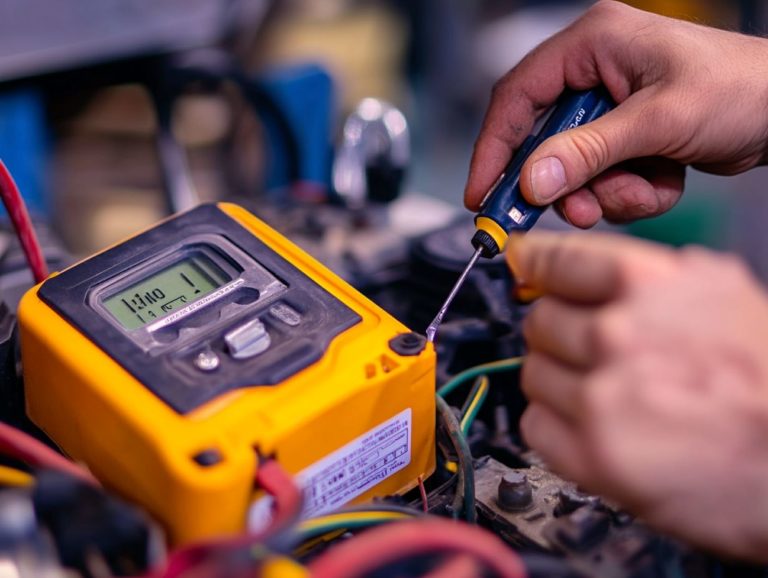How to Test Your Car’s Battery Life
When it comes to keeping your car running smoothly, understanding your battery is essential.
From the various types of batteries and their specific functions to recognizing signs of weakness, being well-informed can save you from unexpected breakdowns. This guide covers crucial topics, including how to test your battery s voltage, the use of a battery load tester, and exploring alternative testing methods.
You ll also discover practical tips for maintaining your battery to ensure it lasts longer.
Let s dive in and empower you with the knowledge to keep your car running smoothly!
Contents
- Key Takeaways:
- Understanding Car Batteries
- Signs of a Weak Battery
- Testing Your Battery’s Voltage
- Using a Battery Load Tester
- Other Methods of Testing Battery Life
- Maintaining Your Car Battery
- Frequently Asked Questions
- Q1: How do I know if my car’s battery needs to be tested?
- Q2: What tools do I need to test my car’s battery?
- Q3: How can I safely test my car’s battery?
- Q4: How do I use a voltmeter to test my car’s battery life?
- Q5: What if my battery reading is below 12.4 volts?
- Q6: How often should I test my car’s battery life?
Key Takeaways:

- Regularly test your car’s battery voltage to catch any issues before it fails completely.
- Load testing can accurately determine the remaining lifespan of your battery and help you avoid unexpected breakdowns.
- Proper maintenance, such as keeping terminals clean and using a battery tender, can significantly prolong your car battery’s life.
Understanding Car Batteries
Understanding car batteries is essential for you as a vehicle owner, given their critical role in starting your engine and powering various electrical systems.
By maintaining your battery properly, you can significantly extend its lifespan, ensuring your vehicle operates reliably.
There are different types of car batteries, like lead-acid and lithium-ion, each serving distinct functions. This underscores the importance of selecting the right battery tailored to your specific automotive needs and usage patterns.
Types of Batteries and Their Functions
Car batteries fall into two primary categories: lead-acid and lithium-ion, each tailored to specific automotive needs.
Each battery type varies in composition and performs differently. Lead-acid batteries, celebrated for their reliability and affordability, have long been the go-to choice for vehicles, primarily serving to start engines and power electrical systems.
On the other hand, lithium-ion batteries are lighter and more efficient, offering quicker recharge times and extended lifespans, which is why they re becoming the preferred option in modern electric vehicles.
Grasping these distinctions gives you the power to make informed decisions about which battery type aligns best with your driving needs and lifestyle preferences.
Signs of a Weak Battery
Recognizing the signs of a weak battery can spare you from unforeseen car troubles and ensure your vehicle operates smoothly.
You might notice symptoms like difficulty starting the engine, dimming lights, or erratic electrical systems. These often signal battery issues that need your immediate attention.
By regularly monitoring your car battery’s health and voltage, you can significantly enhance its lifespan and reliability, keeping you on the road without a hitch.
Common Symptoms of Battery Failure
Common symptoms of battery failure that you should watch for include dim lights, electrical issues, and a failure to start the engine, all of which can signal underlying battery problems.
These signs often indicate diminished battery voltage or insufficient charge retention, ultimately compromising performance. For example, if you notice dim lights, it might suggest a weakening battery, impacting not only your visibility but also the proper functioning of electronic systems.
Electrical issues, such as flickering dashboard lights or malfunctioning accessories, could further imply potential internal faults or corrosion at the battery terminals.
If your engine fails to crank or starts sluggishly, it s a clear signal of inadequate power supply. To tackle these concerns, it s wise to regularly inspect battery connections for any signs of corrosion, check fluid levels if applicable, and consider testing the battery s voltage with a multimeter to ensure everything is operating at optimal performance.
Testing Your Battery’s Voltage

Testing your car battery’s voltage is a crucial step in assessing its health and performance. With a voltmeter in hand, you can effortlessly check the voltage to determine if your battery is functioning properly or if it needs a closer look or replacement.
A precise voltmeter reading not only saves you money and time, but also identifies whether your battery is at risk of failure. This allows you to take action before it s too late.
Step-by-Step Guide to Voltage Testing
Using a voltmeter to check your car battery’s voltage is a straightforward process that helps you identify potential issues. This simple yet effective method gives you the power to assess your battery’s condition efficiently, ensuring reliable performance.
To get started, gather the right tools, including a digital voltmeter or a device that measures electrical voltage. Prioritize your safety by wearing protective gear such as gloves and goggles.
- First, turn off the vehicle and locate the battery terminals.
- Connect the red probe to the positive terminal and the black probe to the negative terminal.
- Read the display on the voltmeter to uncover the voltage level.
Ideally, a fully charged battery should register between 12.6 and 12.8 volts. If the reading dips below 12.4 volts, it may be time to consider charging or even replacing the battery. Always exercise caution around car batteries, as they contain corrosive substances and can pose hazards.
Using a Battery Load Tester
A battery load tester is crucial for assessing your vehicle’s battery health. It provides important insights into how well your battery can hold a charge under load.
By simulating the conditions of a cranking engine, it allows you to evaluate whether your battery can perform effectively in real-world situations. This is vital for ensuring your vehicle’s overall reliability.
How Load Testing Can Determine Battery Life
Load testing is a vital process that allows you to evaluate your battery’s health by assessing its performance under simulated conditions.
Start with a thorough visual inspection of the battery, checking for any signs of corrosion or physical damage. After that, a specialized load tester steps in, applying a controlled amount of current for a specified duration. This lets you see how well your battery holds up under pressure.
The insights you gather from these results are invaluable. They reveal your battery’s capacity and overall health, helping you understand how well it can hold a charge and how much longer it might remain effective. For vehicle owners, grasping these results is crucial. They guide you in determining when maintenance is necessary, ensuring your vehicle performs optimally while steering clear of unexpected failures.
Other Methods of Testing Battery Life
Beyond voltage and load testing, there are several effective methods to assess battery life and health. Engaging in visual inspections for signs of corrosion, meticulously checking terminal connections, and employing battery monitoring systems are important practices.
These techniques enable you to identify potential issues early on, preventing them from escalating into more significant problems. Knowing your battery s health can save you from those unexpected breakdowns!
Alternatives to Voltage and Load Testing

Alternatives to traditional voltage and load testing include thorough battery inspections and monitoring for corrosion issues.
Battery inspections provide critical insights into the health of your battery. Look for signs of swelling, leakage, or discoloration each can indicate damage or degradation.
Monitoring for corrosion means examining the terminals and connectors for any buildup that could impair performance. Using a device that measures electrical power can give you a comprehensive understanding of the battery’s functionality.
These methods enhance traditional testing. They help you find problems before they lead to major battery failures, ensuring reliability and longevity in performance.
Maintaining Your Car Battery
Proper maintenance is crucial for ensuring your car battery’s longevity and optimal performance.
Ignoring maintenance can cause your battery to fail sooner and may create safety risks.
Start conducting regular inspections today! Clean any corrosion from the battery terminals and monitor your battery s overall health. These key practices are essential for every vehicle owner, helping you avoid significant battery problems in the future.
Tips for Prolonging Battery Life
To extend the life of your car battery, embrace effective maintenance practices. Regularly check voltage, promptly address any battery issues, and ensure proper usage to enhance performance and longevity.
Extreme heat or cold can hurt battery performance. Whenever possible, park in shaded or climate-controlled areas.
Inspect the battery terminals for corrosion and ensure clean connections to prevent unnecessary drainage.
Consider investing in a smart battery charger to maintain optimal charge levels during inactivity.
Familiarize yourself with the signs of battery wear like dimming headlights or slow engine cranking to replace it on time and avoid unexpected breakdowns.
Frequently Asked Questions
Q1: How do I know if my car’s battery needs to be tested?
A1: If your car struggles to start or the battery warning light is on, it’s time to test your car’s battery life.
Q2: What tools do I need to test my car’s battery?

A2: You need a voltmeter or multimeter, safety glasses, and a wire brush to clean the battery terminals.
Q3: How can I safely test my car’s battery?
A3: Turn off your car and remove the keys before testing the battery. Wear safety glasses and gloves to protect against battery acid.
Q4: How do I use a voltmeter to test my car’s battery life?
A4: Set the voltmeter to DC voltage. Touch the positive (red) lead to the positive terminal and the negative (black) lead to the negative terminal. A reading between 12.4-12.6 volts indicates a fully charged battery.
Q5: What if my battery reading is below 12.4 volts?
A5: If your reading is below 12.4 volts, it s low and may need recharging or replacement. Consult a professional mechanic for guidance.
Q6: How often should I test my car’s battery life?
A6: Test your car’s battery every 3-6 months, especially before long trips or during extreme weather. This helps ensure your battery is in good condition to handle your vehicle’s demands.






